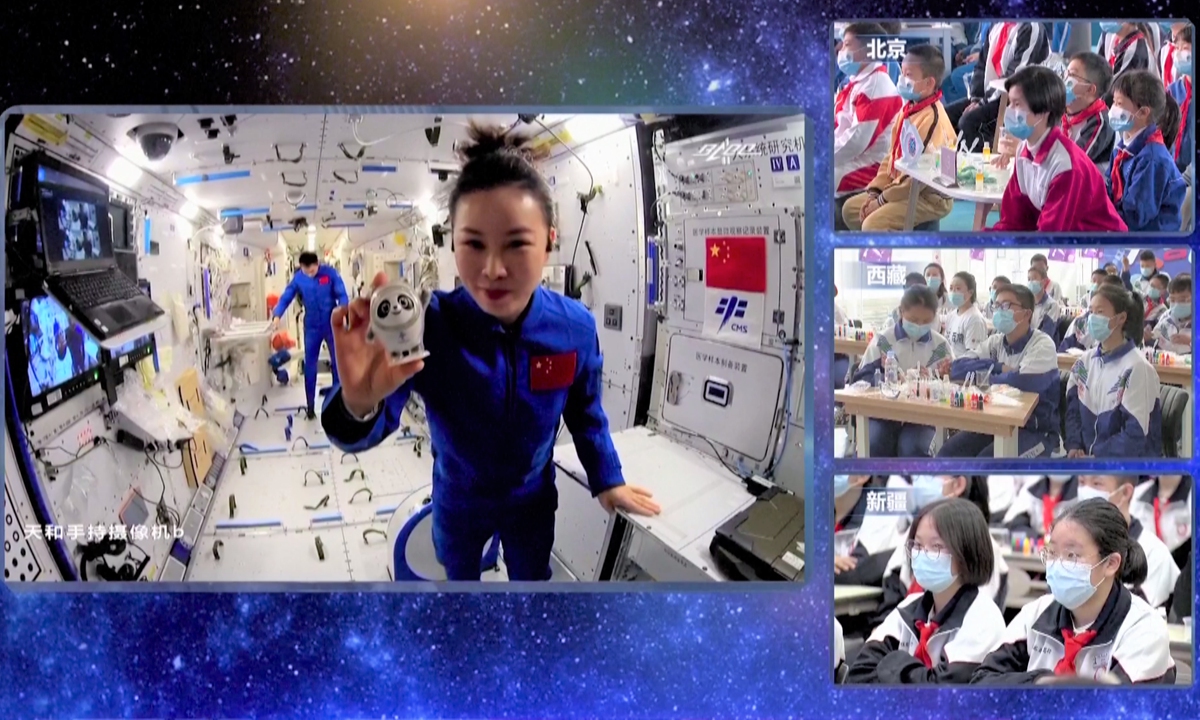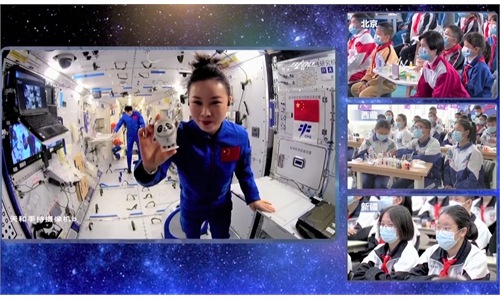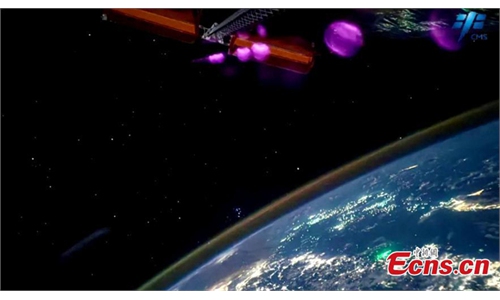Shenzhou-14 set to deliver 3rd session of Tiangong Classroom lecture live from space station

Shenzhou-13 taikonaut Wang Yaping shows Beijing Winter Olympic Games mascot Bing Dwen Dwen during the second live session of the Tiangong classroom lecture series from China's Tianhe space station on March 23, 2022. Screenshots show students from Beijing, Xinjiang Uygur and Xizang autonomous regions watching the live session. Photo: VCG
Three taikonauts of the Shenzhou-14 crew are set to deliver the third live session of the Tiangong Classroom lecture series from the China Space Station combination at 3:45 pm on Wednesday, the Global Times learned from the China Manned Space Agency (CMSA) on Tuesday.Continuing the tradition of the series, the lecture will be carried out in a space-ground interactive manner, during which Shenzhou-14 manned spaceflight mission commander taikonaut Chen Dong and his fellow crewmembers Liu Yang and Cai Xuzhe are expected to present the live and working scenes inside the Wentian lab module.
They will demonstrate scientific experiments and have a live question and answer session when interacting with classrooms on Earth, the CMSA said in a statement it provided to the Global Times on Tuesday.
The contents of the Tiangong Classroom lecture series, according to the CMSA, are proposed by young students via news media, education application Xuexi Qiangguo as well as the website of the CMSA.
The Shenzhou-13 crew delivered the first two live space sessions from the China Space Station during their six-month stay in space. The Wednesday session will be the first for their successors in the Shenzohu-14 crew.
In the Wednesday session, the Shenzhou-14 crew will show the audience around the space station's first lab module Wentian, which was launched on July 24, and introduce equipment and appliances onboard including the scientific glove cabinet, the biological technology experiment cabinet and the variable gravity experiment cabinet.
In the in-orbit experiment session, the taikonauts will demonstrate the capillary phenomenon of liquids in a weightless environment, and explain the importance of the phenomenon and its engineering applications.
Also, in an interesting experiment, they will show the young audience on Earth the different behaviors of liquid and liquid-solid mixtures under the same impact of a weightless environment.
They will also introduce an in-orbit life experiment featuring experimental seeds of thale cress and rice inside the life experiment cabinet, demonstrating the sampling operation.
The seedlings of thale cress have grown leaves, and the rice seedlings have grown some 30 centimeters high as of late August, the CMSA said then. The experiment is expected to complete a full life cycle "from seeds to seeds," and during the process taikonauts will collect samples and then freeze and preserve them, before finally returning them to the ground for analysis.
The second live class from China's space station was held on March 23, attended by students from three classrooms across China. The main classroom was located in the China Science and Technology Museum in Beijing, while others were in Lhasa in Southwest China's Tibet Autonomous Region and Urumqi in Northwest China's Xinjiang Uygur Autonomous Region.
The first was held on December 2021, with a total of 1,420 students from primary classrooms at the China Science and Technology Museum in Beijing, as well as other classrooms in Nanning, South China's Guangxi Zhuang Autonomous Region, Wenchuan county, Southwest China's Sichuan Province, and the Hong Kong and Macao special administrative regions, taking part in video communication with the Shenzhou-13 crew.
China has scheduled four key missions to complete the building of the China Space Station before the end of 2022. On Tuesday, the Long March-7 Y6 carrier rocket that is set to launch the Tianzhou-5 cargo spacecraft to the space station arrived at the Wenchang Space Launch Site in South China's Hainan Province. The Mengtian lab module, the final section of the basic structure of the China Space Station, completed its planned propellant fueling on Sunday, and is expected to be launched in October.
The Shenzhou-15 manned spaceflight mission and the return of the Shenzhou-14 will also be carried out before year-end, the CMSA said on Tuesday.
As of press time, the spacecraft that are set to perform these missions had all arrived at the Wenchang spaceport and Jiuquan Satellite Launch Center. Space control and monitoring systems are working steadily to ensure the safe operation of the space station, according to the CMSA.



